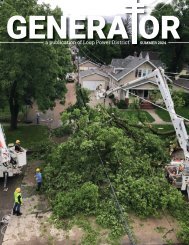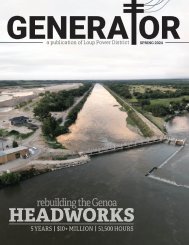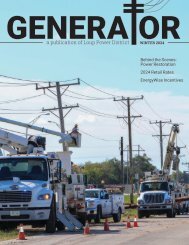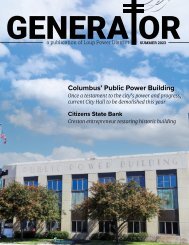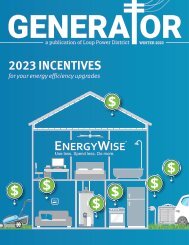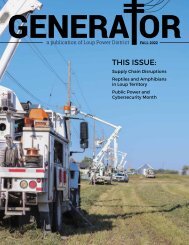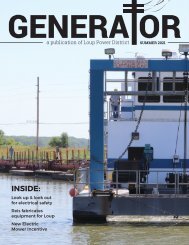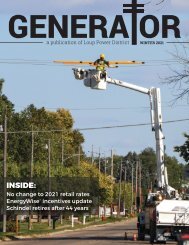You also want an ePaper? Increase the reach of your titles
YUMPU automatically turns print PDFs into web optimized ePapers that Google loves.
What is the<br />
Southwest<br />
Power Pool?<br />
Our lives depend on electricity, but<br />
most of us have no idea how many<br />
people, machines, and complex<br />
processes work together around the<br />
clock, every day of the year to ensure<br />
the reliable supply of cost-effective<br />
power.<br />
The Southwest Power Pool (SPP) is<br />
a major player in this process. Even<br />
so, the organization remained largely<br />
unknown by the public until the February<br />
2021 winter storm that impacted<br />
more than 170 million Americans.<br />
SPP is a regional transmission organization<br />
(RTO) based in Little Rock,<br />
Ark. It manages the bulk electric grid,<br />
operates a wholesale electric market,<br />
and plans transmission on behalf of<br />
utilities and transmission companies.<br />
Like air-traffic controllers — who<br />
don’t own the planes they direct,<br />
the skies they monitor, or the airports<br />
that serve as travel hubs — SPP<br />
doesn’t own power plants or transmission<br />
lines, but instead directs the<br />
regional bulk power grid to ensure<br />
that electricity gets from where it’s<br />
made to where it’s needed.<br />
Back in February 2021, historic cold<br />
temperatures caused massive consumption<br />
of heat and power, straining<br />
the electric grid. To preserve that grid<br />
and prevent catastrophic failures, SPP<br />
implemented rolling blackouts for the<br />
first time in its 80-year history.<br />
Nebraska Public Power District is<br />
Loup’s wholesale power provider and<br />
has been a member of SPP since 2009.<br />
In turn, Loup is a member of SPP.<br />
While customers throughout the state<br />
and Midwest were frustrated by the<br />
blackouts, the event also highlighted<br />
the benefit of SPP membership.<br />
SPP’s members all shared energy<br />
during the crisis, directing it to where<br />
it was needed the most. This helped<br />
minimize impacts to any one entity.<br />
Those short energy curtailments prevented<br />
the grid from cascading out of<br />
control like it did in Texas.<br />
That state suffered a major power<br />
crisis when the winter storm hit. More<br />
than 4.5 million homes and businesses<br />
were without power — some for<br />
several days — because electric utilities<br />
in state failed to winterize power<br />
sources like wind turbines and natural<br />
gas infrastructure.<br />
In addition, Texas’ power grid is not<br />
connected to national grids, so it was<br />
difficult to import excess energy from<br />
other states during the storm.<br />
Nebraska would have potentially been<br />
in the same situation if it maintained<br />
its own power grid, for example.<br />
Although the state generates plenty<br />
of power, we rely on our neighbors for<br />
help when sustained weather events<br />
— extreme heat or cold — spike the<br />
amount of power we consume.<br />
The arrangement also saves utilities<br />
—including NPPD and Loup —<br />
money at the end of the day. Overall,<br />
SPP’s services provided members<br />
$2.7 billion in net benefits in 2021 at a<br />
benefit-to-cost ratio of 18-to-1.<br />
THE SPP REGION<br />
552,885 square mile service territory<br />
More than 18 million people<br />
949 generating plants<br />
5,180 substations<br />
SPRING <strong>2023</strong> | 11



